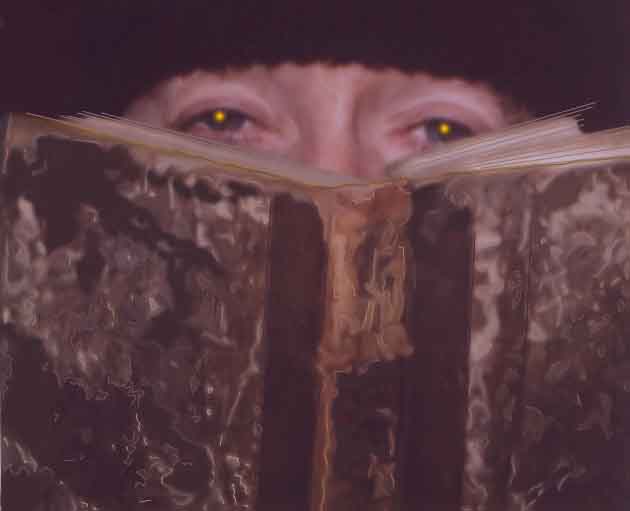









AFFLICTIONS & CURES - W. CHRIS WOODS
[First published as a curatorial essay for a brochure by the Saint Mary's University Art Gallery in Halifax Nova Scotia in 1990.]
For twenty years, the dominant theme in Woods' work has been the relationship between the inside and the outside of the body. He has not abandoned the shaped canvas made with sculptural wood bracing, but lately has tended to use unmounted rag paper as a support for drawing and painting. This exhibition includes paintings, drawings and a video tape.
A 1972 article in artscanada magazine includes, among other illustrations, photographs of shaped three-dimensional paintings of animals with openings in their bodies and a painting of a doctor's head.
A 1974 review of a Canada House group exhibition in London's Financial Times by William Packer describes Woods' work as "canvas objects each shaped to the contours of a single image..." and "The best and most interesting of all the work....They are crudely, even perfunctorily painted, with a deliberate rawness in the handling...."
CW: "...a pig I saw slaughtered when I was eleven years old in France...seeing Goya in the Prado was a revelation...the paradox of beautiful painting with grotesque imagery seemed to me to be a metaphor of life and death..."
The painting may also owe something to Woods having lived in England for ten years during the period of his maturation as an artist. This body-work seems to grow out of an English post-war sensibility: full of of dread, pessimism and mortification of flesh combined with accomplished, even "beautiful," technical handling with an abstract expressionist edge - gorgeous technique with disturbing content. Woods' sources in medical illustration and dental surgery texts also hold a fascination for English painters of the macabre like Francis Bacon, but Woods prefers to cite as influences Goya, Van Gogh, Giacometti and the English painter Frank Auerbach.
CW: "...In 1982 John Doull gave me a medical book, Handbook of Surgical Practice, and I kept going back to it..."
Woods' drawings are made up in series composed of four to six drawings. Each series relates to a specific image or aspect of the overall theme of the body subjected to internal and external forces. The surface quality comes from working and reworking a particular piece using dyes, watercolour, ink, various types of charcoal, conté and pastel.
CW: "...some image hits me...something about the dog's nose interested me...or one head from a medical text...something about the lighting...and I made five or six drawings from the image..."
Woods makes "painterly" work. This kind of painting favours the ambiguous form over the graphic form; a range of thick and thin paint over evenly handled surfaces; figure painting over other traditional genres; and, (when references are widened into art history), Rembrandt over Vermeer; Post-Impressionism over the French Academy, Matisse and Bonnard and Soutine over Dadaists like Arp.
CW: "...black humour has always fascinated me...writers like Kafka, Knut Hamsen, or Malcolm Lowery...it's about sensitivity, it's not fear with make-up on it..."
Music as well as visual art plays a major role in Woods' life. The Babbies Upstairs is an artist's band (of which I am a part) akin to other artist bands in Canada like CCMC in Toronto or the Nihilist Spasm Band in London. All three groups improvise performances, and they share a visual art sensibility. The Babbies and the Spasm Band also want to be funny. The Port Authority is another band Woods plays with, an all-percussion group inspired by Latin American and African drumming.
CW: "...drumming and music play a big part in staying awake...aware...you blow a horn and build a certain structure from it...the improvising and the form happen together..."
Woods tends to separate his oeuvre into clear bodies of work which may conveniently be categorized by medium - or perhaps more accurately, by humour. He can be boisterously funny in Babbie performances, high-mindedly serious in the painting, and emotionally eclectic in his choice of images for making video tapes. (Woods' video tapes, like his 1988-89 Sanctuary of the Heart included in this exhibition, adapt textural and thematic motives of his painting, and combine them with his own music.)
CW: "...trying to create something that helps us look into ourselves...questioning our emotions and desires...art making as a form of teaching (oneself)...not about pictures as a commodity..."

|
|